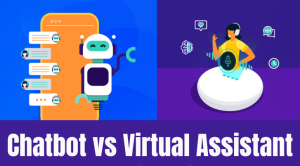Chatbots vs AI Virtual Assistants: Understanding the Differences🤖
Chatbots vs AI Virtual Assistants: Understanding the Differences🤖
Chatbots and AI virtual assistants are requisites that perform vital roles in helping businesses and individuals save money, minimize efforts, and maximize productivity. The chatbots are deployed in organizations to improve customer satisfaction through always-available customer support.
They are also used for tracking consumer data and behavior, product research, and providing consumers with recommendations. On the other hand, AI virtual assistants support human beings in their day-to-day lives by performing tasks such as giving reminder alerts, playing music, calling someone, controlling smart devices, and translating spoken words into written ones.
While chatbots and digital virtual assistants may appear very related or perhaps identical, they are actually different when it comes to the features, the role they play, the conversational interface, and the use case scenarios. Read on to discover these differences, how these technologies are changing the world today, and which other fields may be impacted.
What are Chatbots?
Chatbot is defined as an artificial intelligence program that uses text or audio prompts to interact with customers and receive corresponding replies. The primary functions of the Chatbots are to solve technical problems, reply to customers’ questions, assist customers, and provide satisfactory solutions. Generally, chatbots deal with recurrent tasks and communication instances leaving employees with other tasks to handle.
Chatbots can be rule-based or AI-powered:
Rule-based chatbots: These bots operate under a set program and script to handle them. They search for the input given by the users for specific keywords or phrases and act upon it. Though they help in engaging the customers, they tend to fail in handling complicated questions and may even generate insignificant messages.
AI-powered chatbots: AI chatbots that are based on machine learning and natural language processing present enhanced interactivity than other forms of chatbots. They are trained on rich data and manage to deal with interactions, and situations, and remember the context. Despite the potential negative aspects such as lack of precision, they are particularly good at understanding inputs from the user.

Understanding AI Virtual Assistants
AI Virtual Assistants can be defined as self-service applications that incorporate the use of AI technologies. They can book appointments for meetings; they also can be programmed to guide; they can shop; they can turn on and off the devices among other things.
Key differences between chatbots and AI virtual assistants:
- Functionality and applications: Different are chatbots which operate with the help of programmed rules or AI to analyze the input from the user and AI virtual assistants who use actual AI to interact with the users.
- Customer engagement and experience: Both drive customer interactions; however, AI virtual assistants offer better interaction since they collect, process, and retain consumer information differentials.
- Use cases and industries: Chatbots find applications in cases such as customer service and shopping while AI virtual assistants are applicable in personalized tasks automation of homes, and the acquisition of information.
Therefore, chatbots and AI virtual assistants are crucial elements for the effectiveness of processes and users. Awareness of those differences and uses may assist the selection of the pertinent technologies in business and personal settings. The future trends are shown in two aspects: the development of conversational AI, and the bipartisan with different sectors.

